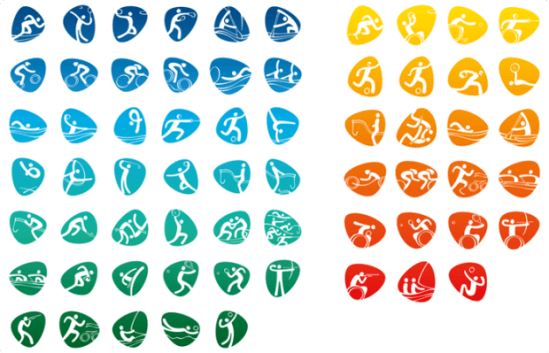
While the Olympics have a lot of well-known sports like gymnastics, track and field, equestrian, and others, sometimes you have sports that are kind of odd. Others might be boring to watch while some might make you asking “What the hell is that?” or “How do they call this a sport?” Over the years, the Olympics has featured all kinds of sports in its modern history. Some of them have become all-time favorites, while others not so much. As to why these sports were ever held in the Olympics, I sometimes I have no idea. Sometimes this has to do with tradition. Sometimes it might be to lobbying efforts. And sometimes, it might be due to a sport simply being popular at one part of the world. Sorry, but you’ll have people in the world who actually like sports like team handball. At any rate, the sports I present all have degrees of various levels of ridiculousness. Some of them might seem stupid while others seem boring or insane. So for your reading pleasure, here is a list of ridiculous Olympic sports I managed to compile.
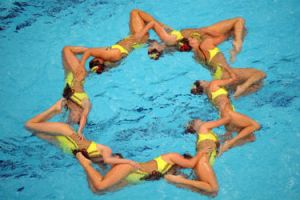
- Synchronized Swimming – From River Front Times: “We admit it. This sport is almost too easy to make fun of. But we’re not here to dismiss the event entirely. The team competition, in which a group of women collectively turn themselves into aquatic kaleidoscopes, is actually kind of cool. (Kind of.) No, what we find completely inane is the smaller (and less dazzling) duet competition. Sorry, ladies, but flopping around in a pool with your girlfriend is NOT a sport. And, by the way, why is it that synchronized swimming remains a female-only event when traditionally male sports such as boxing and wrestling have all added women in recent years? The Thompson Twins (from one of the best SNL skits ever) would not approve.”
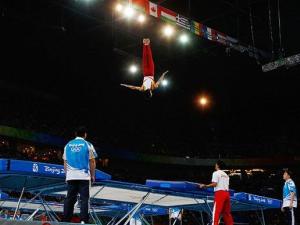
2. Trampoline- From River Front Times: “Sure, trampolines are lots of fun. And as the character Todd Flanders once noted on The Simpsons, each leap on the spring-loaded canvas “brings us closer to God.” But an Olympic sport? In 2000 the IOC agreed with young Flanders when — to the dismay of the pogo-stick and hulu-hoop lobbies — it vaulted trampoline jumping from backyard activity to the pantheon of the Olympic games.”

3. Cycling BMX- From River Front Times: “Let’s be frank. Some “sports” just need to remain in the “X-Games.” That’s the case with BMX, which debuted in Beijing in ’08 and was somehow invited back for 2012. C’mon, IOC. “Do the Dew” and dew not extend the same invitation for 2016.” From SBNation: “I guess the Olympics have to do something to get Doritos and Mountain Dew into the Summer Games. If more people knew about BMX being part of this prestigious event, maybe the MMA lobbyists could just have a presentation to the Olympic Committee where they just point to a picture of BMX and go, ‘C’MONNNNNNNN.’”
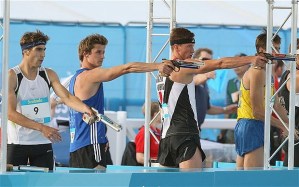
4. Laser Pointing (a.k.a. Modern Pentathalon)- From River Front Times: “Baron de Coubertin introduced the modern pentathalon to the 1912 Stockholm games because he believed this “sport” tested “a man’s moral qualities as much as his physical resources and skills, producing thereby a complete athlete.” The event combines fencing, horse jumping, shooting, a 3-K run and 200-meter swim. This year in a move that makes the modern pentathlon ever-more-modern (and to the great delight of video gamers who’d never considered themselves athletes before), the competition will add a twist. Instead, of firing lead pellets during the shooting event, pentathaloners will fire a laser pistol powered by a AA battery.”
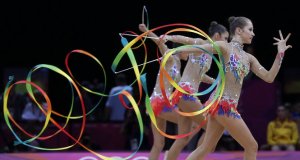
5. Rhythmic Gymnastics- From River Front Times: “Like a dry-land version of synchronized swimming (only campier), rhythmic gymnastics features a team of competitors prancing around to music while waving ribbons and twirling hoops. The sport debuted in the 1984 Olympics when a real gymnast — Mary Lou Retton — was murdering it on her way to Olympic gold and a Wheaties box. Today rhythmic gymnastics is dominated by the Russians, who’ve swept gold medals at the last three Olympics and are favored to do so again in London.” Once again, this was written in 2012. However, given the Russian dope scandal, other teams might have a chance to compete if the Russian team is banned from competition in 2016.

6. Equestrian Dressage – From River Front Times: “Imagine a person sitting atop a horse as it prances, pirouettes and jumps unnaturally around a ring. Congratulations! You’ve just envisioned the dumbest “sport” of the Olympic games: dressage (pronounced like massage). We’re told that the ancient Greeks developed dressage to train horses for war, yet today’s version is a far flashier and dubious version of the original. A modern-day equivalent to dressage would be a lowrider competition in which hydraulics make Oldsmobile Cutlasses do things God (and G.M.) never intended.” From Heavy: “If I expressed earlier that any of the categories were somehow elitist, I apologize, we’ve truly found the ultimate sport of the one percent. Hire a trainer to train your horse to dance. The horse does almost all the work, the trainer does the rest, and you get to sit back and take credit for it all. Oh, and you have to own a horse. That’s why it’s no surprise that Mitt Romney (Hey, Mitt!) has a horse in the dressage competition this year. A horse named Rafalca. Oh, look, Rafalca has her own Twitter account (Hey, Rafalca! Good luck!).”During the 2012 Olympic Games in London, Stephen Colbert got a lot of comedy out of this sport, especially since Mitt Romney had a horse compete in this event.
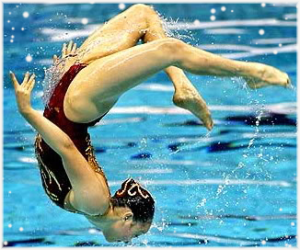
7. Solo Synchronized Swimming (1984-1992)- From Dish Magazine: “You read that right: Solo Synchronized Swimming; the question of how, exactly, to judge how well one person can synchronize with himself was never really answered. While many other events on this list can be forgiven for being a one-time mistake, this oxymoronic stinker bored people for three consecutive Olympics.” As if synchronized swimming wasn’t stupid enough. Yeah, I don’t know how this sport is possible. Oh, it’s to music. Well, it’s as bad as it sounds.
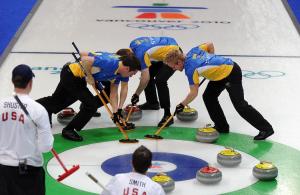
8. Curling- From Dish Magazine: “Created in Scotland, mastered in Canada, ignored everywhere else; this sport was made official again in 2006 after a brief 82 year hiatus. It involves sliding rounded stones of granite down an icy corridor to stop on a giant target. Not so weird, right? It gets better; after the stones are released two other teammates use brooms to furiously scrub the ice in front of its path like over-caffeinated high school janitors. Besides giving the ice that fresh, clean feeling, it’s supposed to help the team control the speed of the stones.” It’s said to be very popular in Canada after ice hockey. At least the Canadian obsession with ice hockey is understandable. Not sure about this. More like a version of shuffleboard with large rocks.

9. Pigeon Racing (1900)- From Dish Magazine: “Horses? Of course. Dogs even. Turtles and frogs just for fun? Whatever floats your boat. But pigeons? Never mind how you’re supposed to get a pigeon to go around a racecourse, what about the inherent hazards of letting a flock of pigeons fly over crowds of people? No mystery here as to why this wasn’t picked up for the 1904 Olympics.” I’d love to see how this sport was executed. Might be very interesting to watch (from a comic perspective). Wonder how much bird shit they had to clean up after that.

10. Skijoring (1928)- From Mandatory: “Albeit a demonstration event, this one was just like dog sledding, minus the dogs and plus a horse. Competitors would strap on skis, and essentially hold on for dear life as their horses ran them through a course. The contestant to finish the course the quickest won. The sport didn’t last past its inaugural run.” How about they include sled dog racing instead? At least it doesn’t look stupid. Oh, wait, they discontinued that, too?

11. Ski Cross- From Dish Magazine: “Take a guy, put him on two skinny pieces of waxed fiberglass, give him two long sharp poles, and send him down a snowy forested hill at speeds most people don’t experience outside of the interstate. Sounds dangerous enough, right? Ok, now imagine sending four people at a time careening down the same hillside; that’s Ski-Cross.”
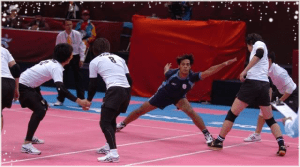
12. Kabaddi (1936)- From Dish Magazine: “Many noble Olympic traditions got their start at the 1936 Berlin games: The Torch Run, the Parade of Nations, and Kabaddi. Actually, scratch that last one; Kabaddi didn’t make it past that year. Two teams, each on one side of the field, send one person at a time to tag, wrestle, and generally harass the other team’s members for points. The catch? They have to hold their breath the whole time. While teams of blue-faced men playing tag sounds entertaining to me, it wasn’t good enough for another round of Olympic glory.”
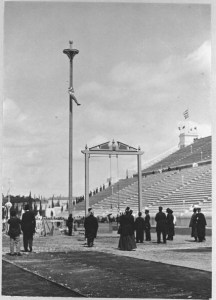
13. Rope Climbing (1896-1932)- From Dish Magazine: “While most of us only know rope climbing as one of those things we couldn’t do in gym class, around the turn of the century being a speedy rope-a-dope could earn you a spot in Olympic history. The thigh-burning event was cancelled after the IOC caught some athletes trying to sneak out during 5th period. I think I speak for everyone who ever wriggled helplessly two feet in the air when I say ‘good riddance.’” From Mandatory: “Sure, it’s a feat of strength, but honestly, who climbs a rope unless they’re trapped down a well? This one had a pretty impressive tenure, but that didn’t stop it from getting the boot. The event was very simple but — as silly as this sounds — difficult. Competitors started in a seated position and could use only their arms to climb to the top of a rope. Form and speed were also judged since contestants didn’t always make it to the top.”
14. Greek Navy 100m Swim (1896)- From Dish Magazine: “Ah Greece, not only the country that started the ancient Olympic games, but also the epicenter of learning and culture for Western Civilization. Maybe that’s how they got away with creating an event open only to men in their Navy. Needless to say, they swept all three medals in this event. So, why was Canada’s idea for the “Canadian Mountie Long Jump” rejected for this year’s Olympics?”

15. Biathlon- From Dish Magazine: “Like Skijoring, this sport started out as a Scandinavian military exercise. Unlike skijoring, it’s still around and a lot less fun to say. Biathlon, sadly, is not a triathlon for impatient people; it’s skiing and shooting in one mind-numbing combination. And if you’re picturing a James Bond-type event with athletes racing down hillsides mowing down targets with dual-fisted Uzis, you are way off. Think Dick Cheney hunting pheasant while cross country skiing. Yeah… No one’s going to accuse Biathlon of earning its Olympic cred by being exciting.”
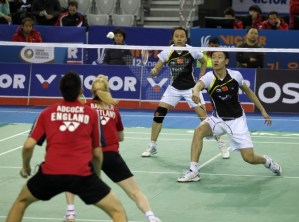
16. Badminton- From Heavy: “Otherwise known as the sport fancy ladies play while wearing fancy hats during their tea breaks. Just thinking about badminton makes me want to talk in a high-pitched voice and an English accent like a cross between a cross-dressing Monty Python sketch and a Jane Austen novel, except from a much more American perspective. “Oh, hello there, Mrs. Bigglesworth. So nice of your to join. May I interest you in a crumpet during your serve? I assure you they are quite a delight.” “I’m sorry, but I’m afraid my dear complexion simply cannot handle sugary confections without breaking out in hives.” I think I may have moved to southern lady at some point in my head there.” When my mom heard about the London Olympic badminton cheating scandal, this is what she said, “I am shocked, shocked! Badminton is in the Olympics? That’s on the level of Olympic tetherball!”
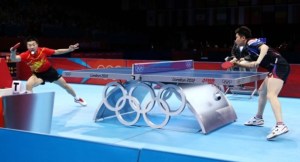
17. Ping Pong- From Heavy: “Remember going to rec centers or after-school programs or camp and there was always one kid who was unbelievably better than everyone else at ping pong (probably because his parents were divorced so they bought him a ping pong table to buy his love, but instead he just used that table to work out all the guilt and loneliness their divorce caused him — I’m just guessing) and would take over the one ping pong table and would never relinquish it? He’d just stand there smugly daring people to play him and you had to if you wanted to play ping pong because he’d just camp out there every single day. Eventually people would just stop playing because it was no fun getting creamed by him and he was such an unremitting douche. And one day you’d get there before him and happily start playing with a friend, but then he’d show up and start critiquing the game until it wasn’t fun anymore and you just gave up the table to him.”
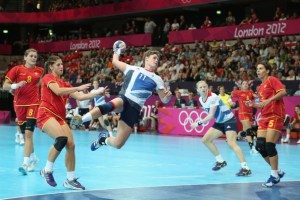
18. Handball- From Heavy: “This is the sport you were forced to play in gym class because it was really cool and you were totally going to love it. Only you didn’t and everyone broke the rules constantly because no one understood them. Good times. You play on teams and it’s very similar to playing soccer with your hands. The idea is to throw the ball into the goal. The ball is moved up the court by passing, dribbling, and walking. Players can take up to three steps without dribbling and then can take another three steps after they dribble the ball. A player with the ball who stops moving has three seconds to pass the ball. The number three is apparently rather important.” From SBNation: “Okay, this is not the thing where uncomfortably-sweaty and ripped middle-aged dudes wear a coal miner’s glove and whack a racquetball against a wall in a New York public park. This is a completely different sport, which is sort of a combination between basketball, soccer and that American Gladiators thing where you have to juke the roided guy in order to jam a four-square ball into a clear cylinder.” My dad always complains on how they once took out baseball and softball but left this sport in. Because he thinks it’s one of the stupidest sports he’s ever seen. Briefed adds, “If handball is an Olympic Sport, why isn’t dodge ball? Seriously, add dodge ball.” Exactly.

19. Racewalking- From Heavy: “Racewalking is hilarious. Who knew all those mall walkers were training to be Olympians. Racewalking is hilarious because all of its participants are trying to go as fast as they can to win a race, but without running. One foot has to be on the ground at all times or the competitor is disqualified, so stride lengths are reduced. The result is a very funny looking walk. Watch the video and see for yourself. I’ll wait. Did you watch it? Hahahaha. I’m sorry, racewalkers, I know you work hard, but that doesn’t make it less funny. I honestly can’t think of any way to make fun of racewalking that’s funnier than the event itself. Okay, Olympics, you’re starting to win me over again.” According to USA Track & Field rules: “Race walking differs from running in that it requires the competitor to maintain contact with the ground and straighten their front knee when the foot makes contact with the ground, keeping it straightened until the knee passes under the body.” You mean this is a thing? How is this a thing?
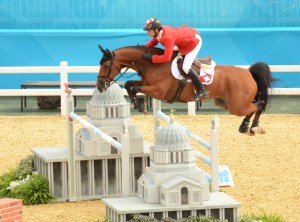
20. Equestrian Jumping- From Heavy: “Let’s just say you heard the words horse ballet and thought, “Well, I guess that’s kind of crazy, but what else you got?” How about a horse obstacle course? Yep, horse obstacle course is an Olympic sport. But that’s not all. The obstacles the horses need to steer around or jump over are out-of-their-minds ridiculous. Things like a castle or a re-creation of the planet Saturn.”
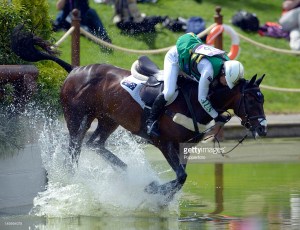
21. Equestrian Eventing- From Heavy: “So, horses jumping over ridiculous items wasn’t enough for you? Ok, how about horse triathlon? Horse triathlon. When I first heard that phrase, my brain exploded. I’m only alive today thanks to the power of duct tape. What? How is a horse triathlon a thing? I guess I should stop asking that after horse ballet and horse obstacle course, but okay. Eventing includes dressage, cross-country, and show jumping. We already know dressage is horse ballet. Cross-country is a horse obstacle course, but without the crazy obstacles. The obstacles tend to be more along the lines of logs which I guess is less crazy than Saturn. It’s an endurance test. Show jumping has the horse given a certain amount of time to, as cleanly as possible, clear the jumps of a course.” I kind of miss the good old days in Ancient Greece when you had Olympic chariot and horse racing. Sure they may be dangerous as hell but at least you got a great chariot racing scene in Ben Hur.
22. Swimming Obstacle Race (1900)- From Cracked: “First, participants had to climb up a pole and slide back down before getting into the water. Then they swam out to a barrage of boats, which they had to climb up on, and then run across to get back into the water. This was followed by more swimming, and then yet another group of boats, which they swam beneath to reach the finish line. This was presumably after they spun around a bat 10 times and passed the orange back and forth without using their hands, of course. But there’s another twist: There were no swimming pools in turn of the century France big enough to play a good game of Miscellaneous Water Bullshit, so they had to hold the event in the Seine River, which, at the time, was the outlet to the Paris sewer system overflow. Because of this “oversight,” many of the competitors also had to struggle against the current of the river, a dangerous and exhausting process for any swimmer, even when it’s not mostly comprised of Frenchman poo.”
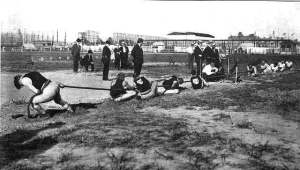
23. Tug of War (1900-1912, 1920) – From Business Insider: “This grade school game consisted of teams of eight on each side of the rope. To win, one team had to pull its opposition six feet — or, if the five minute time limit had expired, the team which pulled its opponents the furthest would receive the victory. The most controversial tug of war match occurred in the 1908 games, when Great Britain took home the gold despite protests from the U.S. that the Brits wore illegal footwear.” Keep in mind that these weren’t pros competing in this and they were on 8 person times pulling a 6 feet rope. The American 1904 team was an athletic club from Milwaukee. Oh, and the British gold medal team in 1908 a London police force.

24. Tandem Bicycle Sprint (1906-1972)- From Mandatory: “A favorite activity of many TV sitcom roommates, this one is the longest-running event on the list. It was quite dangerous, though, as the sprints took place on a banked track or velodrome. Since it was a timed event, the bicyclists would be moving at top speeds, so wrecks were going to hurt.”
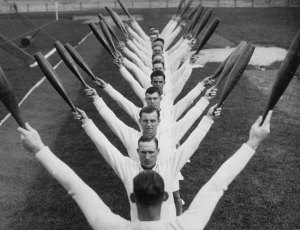
25. Club Swinging (1904 and 1932)- From Business Insider: “Club swingers whirled around bowling pin-shaped clubs quickly around their body and head with routines similar to those of modern day rhythmic gymnastics. American George Roth won the gold medal during the 1932 games. From the Guardian: ‘It was the Great Depression and Roth was unemployed and hungry. Yet he won gold. Seconds after being awarded his medal in front of 60,000 spectators, he walked out of the stadium in Los Angeles and hitchhiked home.’” From MNN: “Men’s club swinging, an official discipline in the Summer Olympics gymnastics program in both 1904 and 1932, is exactly what it sounds like: a bunch of dudes in tights twirling bowling pin-shaped wooden clubs of different sizes and weights in immaculately choreographed patterns. Yessir. Club swinging, or Indian Clubs, was actually a fad-ish method of strength training back in the day before Jane Fonda and Shake Weights hit the scene. And get this: Indian swinging clubs actually served as the inspiration for the modern day juggling club (and of course, the Clubbell). Who knew? In addition to club swinging, other phased out Olympic events in the artistic gymnastics department include rope climbing (1896, 1904, 1924, 1932) and tumbling (1932).”
26. Pistol Dueling (1904 and 1912)- From Business Insider: “Rather than having competitors fire pistols at each other, though, competitors shot at frock coat-adorned mannequins with targets painted on its chests.” From Listverse: “An aristocratic sport for men of bravery and honor, right? Well not when your opponent is a mannequin, as was during the 1906 ‘intercalated’ Games. Competitors took turns shooting at a mannequin dressed in fancy clothes from 20 and 30 meters. It returned to make a brief appearance at the 1912 games, before being banished forever (hopefully).” You can see how that would go. And I guess they used mannequins as targets because using real people was out of the question as well as would’ve resulted in fatalities (as far as I’m concerned).
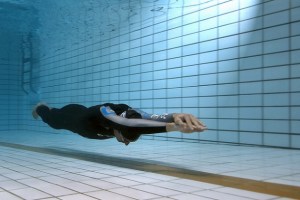
27. Plunge For Distance (Diving) (1904)- From Business Insider: “The event basically consisted of swimmers diving into the pool and staying motionless in the water for one minute. The divers weren’t allowed to propel themselves while in the water. Whoever went the furthest through the water won the event. During the 1904 games, all five Plunge for Distance diving contestants came from the U.S. We imagine this qualifies as one of the least exciting competitions in Olympic history.” Cracked calls this, “the long jump, but with the possibility of drowning.”
28. Live Pigeon Shooting (1900)- From Business Insider: “The goal of the Live Pigeon Shooting event was quite self-explanatory: to shoot (and kill) as many pigeons as possible. Live Pigeon Shooting made its first and only Olympic showing in the 1900 Summer games in Paris. Belgian Leon de Lunden won the gold medal with 21 downed birds. A total of 300 birds were killed during the event.” Guaranteed to anger animal rights people.

29. Jeu de Paume (1900, 1908-1920, and 1924)- From Listverse: “That’s ‘game of palm’ to us non-Francophones. This game was a precursor to real tennis, and was essentially tennis with your hands or a small paddle in lieu of rackets.” So it’s like handball?
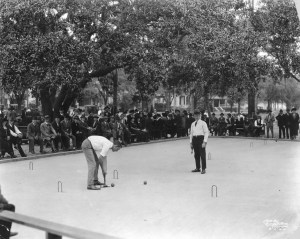
30. Roque (1904)- From Listverse: “An American variation on the French sport of croquet (on a hard surface), this was played during the 1904 St. Louis Olympics. Understandably, as the sport was virtually unknown outside of the US, all of the competitors were American. The sport was dropped after this Games and is widely believed to have been included for the sole purpose of boosting the USA’s medal count.” Still, who the hell in the US still knows what the hell this sport is?

31. Poodle Clipping (1900)- From 11 Points: “For this event (which was a trial event), 128 competitors assembled at the Bois de Boulogne, a park in western Paris. A giant (for the time) crowd of 6,000-plus watched as they competed to see who could trim the most poodles’ fur in a two hour period. The gold medalist was 37-year-old Avril Lafoule from Auvergne, France, who clipped 17 poodles. After the Paris Olympics ended, poodle clipping failed to get the votes to become an official Olympic sport.” Guess poodle clipping was a very emotionally draining activity to watch. Also, how did this become an Olympic sport?
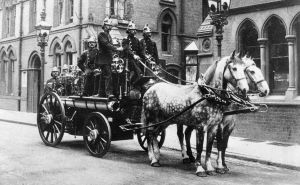
32. Firefighting (1900)- From 11 Points: “It’s not clear what exactly was involved in the firefighting event… like, did they light some random Parisian neighborhood on fire and send all the dudes over there to see who could put their designated house out the quickest? In the volunteer competition, the winner was a team from Portugal; in the professional division, the winner was a group of firefighters from Kansas City. And even though firefighting never became an official Olympic sport… I gotta feel like an Olympic gold medal in firefighting would feel a lot more prestigious than winning one for something like equestrian or rafting.” You know this is something people do as a job or as a voluntary civic duty?
33. Delivery Van Driving (1900)- From 11 Points: “The Paris Olympics featured a ton of different motor races, including delivery van driving. French “athletes” got all three medals, although their names aren’t on record. The motor racing event also included small cars, large cars, seven-seat cars, trucks and taxis. It looks like France really dominated the event — a guy from the U.S. got a bronze in the small truck division, a German got a bronze in a large car distance race, and, other than that, it was all French victories. Meaning that this was possibly the brightest moment in the history of both Peugeot and Renault.” To have it as an Olympic sport today would be like having to recognize NASCAR as a sport.

34. Water Skiing (1972)- From 11 Points: “There were three different events — slalom, figure skiing and jumping. Apparently it was pretty cool… but there was too much controversy about whether or not water skiing involved any actual athleticism… so water skiing never showed up at the Olympics again. It did become a staple at Sea Worlds, though, so it’s got that going for it.”

35. Hot Air Ballooning (1900)- From 11 Points: “During the Paris Olympics, they held several hot air ballooning events, including distance, duration, elevation and targeted stopping. French competitors won every single event. I think I’d like to see hot air ballooning in the Olympics today, partially because I think a bunch of hot air balloons in the sky looks cool… and partially because I know NBC would spend $80 billion on special cameras to record the event. They’d also find a way to let us know how one of the American hot air balloonists overcame a lot of adversity to get to that moment. Man I love Olympic tales of people triumphing over adversity. I hope I hear 50 tonight.”

36. Air Pistol/Air Rifle- From SBNation: “A lot of people probably know that shooting is an event. It takes a lot of skill to be a good marksman. Heck, there are upwards of three reality-show competitions dedicated to how difficult it is to be a world-class sharpshooter. Archery seems legitimate, as does using live ammunition in Olympic shooting. But air pistol and air rifle? Seems a little weird. I think the weirdness is only enhanced by that air rifle sound the guns make. You expect them to be shooting at dancing metal ducks while calliope music plays. Maybe they should win a stuffed animal instead of a gold medal. After all, you can’t snuggle with a gold medal. If this can be an Olympic event, maybe I can join the U.S. Men’s National Team of ‘Get the Water in the Clown’s Mouth.’”

37. Hammer Throw- From Briefed: “There is no way anyone with a sense of humour can watch this event and not laugh. It’s even called “Hammer Throw”! You better start practicing your “Screwdriver Stab”, which might get your into Brazil 2016.”

38. Pelota (1900)- From Cracked: “a game played by two people with a bat on each side of a wall, throwing a ball back and forth until one competitor finally missed it. It’s basically a competitive game of catch. In addition to being generally tedious to play unless you’re a five-year-old or so high that you’re functioning on the level of a five-year-old, the game was also extremely region-specific: Pelota was a traditional Basque game, meaning it was rarely seen outside of Spain and France. In 1900, only two teams (for a total of four people) showed up to the games. The countries? Spain and France of course. A single game was played. Then, having no other competitors, everybody just kind of shrugged and walked away. The score? No one knows: No officials bothered to show up. Although the few fans who did attend said Spain won, so everybody just rolled with that.”
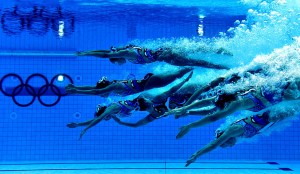
39. Underwater Swimming (1900)- From Cracked: “Pretty self-explanatory, really: competitors swam underwater for time and distance. Sound boring? It’s worse than you think: Remember that this was way before the advent of the waterproof camera, so actually watching the event consisted of staring at a river for a few minutes, and then asking your kid to stop crying or you’ll take him back to the pelota match. Luckily, for entertainment’s sake, the organizers made one big mistake: They held it in a river with a crazily strong current. Fourteen brave souls volunteered to swim in the event. Only two made it the 60 meters in under a minute.” Cracked adds, “Spectators complained about the event because they couldn’t see who was winning or how they were progressing in the murky water, and the only way to tell it was finished was when everybody either climbed out of the water to towel off, or the search and rescue teams arrived.”
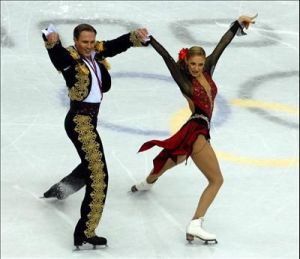
40. Ice Dancing- From Covers: “The IOC describes this alleged sport as “similar to ballroom dancing” and it “does not include overhead lifts or jumps”. Count me out. No lifts or jumps? No Death Spirals or Salchows? How is the average person then supposed to know what the hell is going on? Unless there are jumps, twirls or lifts that involve falls, wobbles and stumbles, we have no idea who the best is. It’s just a bunch of judges getting together with a list of favors and handshakes determining the winners over tea in January. And the dudes in this event seriously need to man up. It looks like most of them are wearing lululemon pants with blouses they stole from Cher’s closet.”

41. Short Track Speed Skating- From Covers: “Is there anything more bogus in sports than that period after a short track speed skating race where the competitors have to wait to see if the judges will let them win or not? If you’re not familiar, a short track race isn’t over until the judges say it is.” From Total Pro Sports: “Just like NASCAR, short track speed skating is occasionally exciting. Sometimes, for example, two racers will swap places several times, and that is fun to watch. Also, sometimes people crash and take other racers out with them, which is also fun to watch. However, most of the time short track speed skating, like NASCAR, is just four people going around in circles with almost nothing happening. The lack of space makes it almost impossible for somebody in the back to make it to the front unless someone wipes out, which means the outcome of the race is almost pre-determined. And of course, if people do wipeout early in a race, the rest of the time you’re just watching one or two people skating in circles.”

42. One Hand Weight Lifting (1896 and 1904)- From Topend Sports: “This event, for men only, was similar to the modern snatch weight lifting event. Only one hand was allowed in lifting the weights. They had to perform lifts with each hand, with the winner determined from the combined score of both hands. The lifters were allowed three attempts. After each had lifted three times, the top three received three more attempts.”
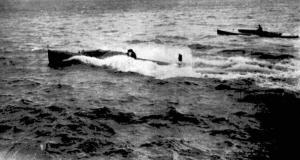
43. Motor Boating (1900 and 1908)- From Topend Sports: “The event, strictly for men, involved racing five laps (or 40 nautical miles) around a specific course. Speeds were not impressive by today’s standards: average speeds were around the 19mph mark. It was not a great spectator sport either, with the action taking place off Southampton, where virtually no one could see the action. Due to bad weather, six out of the nine scheduled races were canceled. No wonder we never saw this event again at the Olympic Games.” Still, putting motor boating in the Olympics again would be like putting race car driving, too. And neither involve much athleticism.

44. Croquet (1900)- From Topend Sports: “There was only ever one croquet competition in Olympic Games history, held in 1900 in Paris. France won all events, which is not surprising as mostly French competitors took part. There were three women competing, but they did not win any medals. These were some of the first women to take part in the Olympic Games. This tournament was also not a success with the spectators. Only one fan watched the events – an Englishman who had traveled from Nice especially for the occasion. No wonder we have not seen this event at the Olympics again.”

45. Golf (1900 and 1904)- From Cage Potato: ”The IOC looks to pick up golf in 2016, and these are the kinds of highlights you can look forward to. Joy? Look, as a game, golf should be played and not seen. Hell, most people can’t play golf without getting halfway-lit first, so that wandering around searching for a little white ball in the expanses of groomed wilderness and man-made constructs doesn’t become a depressing metaphor for their own accomplishments in life. If you actually seek out golf on television to watch, you are a boring human being, and no, I do not want to look at your coin collection.” Sure golf is a great sport to watch for people in a coma.

46. Art Competitions (1912-1948)- From Topend Sports: “The art competitions was part of the vision of the founder of the Olympics, Pierre de Coubertin. Beginning at Stockholm in 1912, the Olympics included an arts competition. Medals were awarded in five categories: architecture, literature, music, painting, and sculpture. As medals were awarded in five categories, the competitions were also named the ‘Pentathlon of the Muses’.” This event was held between 1912 and 1948. As the majority of artists competing were professionals, and the IOC opposed professional competitions at the time, the event was removed. The founder of the modern Olympic Games, Pierre de Coubertin, won a gold medal for literature at the 1912 Games. He entered under the pseudonym “Georges Hohrod and Martin Eschbach”. Another athlete who would later become presidents of the International Olympic Committee, Avery Brundage, competed as an athlete at the 1912 Games, then entered literary works at the 1932 and 1936 Olympics.” Good point: Gives something for the less athletically inclined to win gold medals. Bad: The Olympics are an athletic competition, art competitions have no place there. What’s next Quiz Bowl and Mathletics? Wait, that might seem like a good idea.
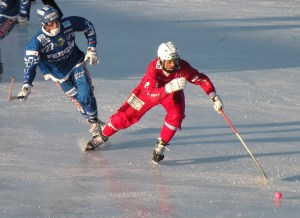
47. Bandy (1952) – From Sports Facts: “Take two favorite pastimes, soccer and hockey, smash them together, and you have one of the strangest winter games ever included in the Olympics. Bandy was a demonstration sport in the 1952 Oslo Winter Olympics and involves two teams of 11 players that compete in a 90 minute game, which is played on a rink the size of a soccer field. They took the sticks and skates from hockey and use a ball instead of a puck. Basically it’s field hockey on ice skates, but with soccer rules. The game itself isn’t necessarily strange, but why bother when you already have an Olympic event in which teams skate around whacking something with a stick? Maybe they’ll renew interest in bandy by tossing elements from football or baseball in the mix as well.”

48. Ski Ballet (1988 and 1992)- PopSugar Fitness: “A combination of figure-skating-inspired choreography plus freestyle skiing, ski ballet — also known as acroski — was a demonstration sport at the Winter Olympics in 1988 and 1992. Unfortunately, after two cycles, the IOC decided that ski ballet wasn’t worthy of being an official Olympic sport. We can’t see how this is possible.”

49. Synchronized Skating- From PopSugar Fitness: “After watching a few synchronized skating routines, I’m having a hard time understanding why this is not an Olympic sport. The choreography is much like that of a freestyle skating or ice dancing routine, except there are eight to 20 people out on the ice moving in perfect unison! It’s never been featured at the Winter Games in any official or demonstrative capacity, but hopefully this will change, since the IOC has reviewed the sport for Olympic eligibility.”

50. Long and High Jump for Horses (1900)- From Mandatory: “Call this one a twofer: two dumb sports for the price of one. These were the products of the 1900 Olympic Games, which saw some of the weirdest events to this day take place due to the fact that the World’s Fair was happening in Paris at the same time. Many of the events were considered demonstration or trial events, to be decided on officially later. No need to describe these two in any more detail, as they are exactly what you think.”

51. Korfball (1928) –From Classic Rock 106.9: “Consider Korfball the red-headed step child of our basketball. The rules are basically the same. However, each team must be made up of 2 men and 2 women. There is also no running or dribbling allowed. The ball is advanced only by passing. Also, the goal is on a pole in the middle of the court rather than each end. In that aspect, I guess it is NOTHING like basketball. It was only an Olympic sport in the 1920 games in Antwerp and again in 1928 in Amsterdam. The game itself is still played all over Scandinavia to this day with championship leagues in existence….can you imagine the “Lebron James” of Korfball?”
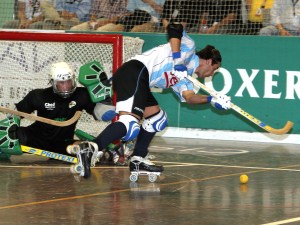
52. Roller Hockey (1992)- From Classic Rock 106.9: “Ice hockey’s slow cousin, roller hockey was only an Olympic sport for 1 year before the powers that be decided it was just too painfully boring to watch. 12 nations competed in the first and last showing of the sport with Argentina walking away with the gold followed by host country Spain taking the silver and Italy bringing home the bronze…..Try being an Italian roller hockey player trying to pick up chicks with ‘I got a bronze medal in roller hockey.’”

53. Glima (1912)- From Classic Rock 106.9: “Glima is the Icelandic sport of folk wrestling. The object was for two men to remain completely upright while trying to get any part of the other competitor’s body to touch the floor all the while circling each other. One major rule….you had to circle the other man in a clockwise motion or else be disqualified. Today you can still catch this sport at any number of alternative lifestyle clubs across the country. Luckily for us, it was only at sport at the Stockholm games of 1912 before the wrestled with the notion that…..maybe, just maybe, nobody wants to see that.”

54. Finnish Baseball (1952)- From Classic Rock 106.9: “Much like American Baseball except the base paths are different and instead of a pitcher, the batter throws the ball up in the air vertically before attempting to hit it. I guess in some ways its like stick ball you use to play on the street. This Finnish version of our national past time was only an Olympic sport for 1 year in 1952 in, you guessed it, Helsinki Finland. Nice try. Maybe if pickling herring were a sport the Finnish would probably dominate.”
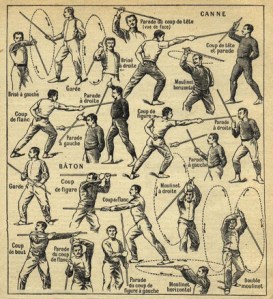
55. Le Canne (1924)- From Classic Rock 106.9: “Once again we venture back to the land of snails and berets, France. This is the French version of fencing, if you want to call it that. Basically the object is to beat another person senseless with a cane. Unfortunately, the committee no longer wanted to see feminine men beat the crap out of each other with canes and canceled the event after the 1924 games in Chamonix.” They also can’t attack each other simultaneously. If one player attacks, the other must dodge or block it. It doesn’t really make great sword fighting.
56. Alpinism (1932 and 1988)- From Business Insider: “In 1924, at the first Winter Olympic Games in Chamonix, the first medals for Alpinism, or mountain climbing, were awarded. The event was not a traditional competition held while the Games were in session, but instead, medals were awarded to the individual or group that had achieved the most notable feat in mountaineering since the previous Games. The first medals were awarded to members of the unsuccessful 1922 British expedition to Mt. Everest. This included seven posthumous medals for those who had died. After two medals were awarded in 1936, there were no further mountaineering merits until the 1988 Calgary Games, when Reinhold Messner and Jerzy Kukuczka were honored for successfully summiting each of the 14 8,000-meter peaks.”

57. Cricket (1900)- From Business Insider: “In 1900, cricket was played as an Olympic sport in Paris, with only two participating teams, Great Britain and France, playing after Belgium and the Netherlands withdrew. Great Britain fielded a team consisting mostly of members of the Devon County Wanderers’ Club, many of them part-time players who had been on a tour of France. The French team was composed of many British expatriates who lived in Paris and competed in the Olympics under the name All-Paris. The game originally was intended to be included as part of the program in the first Olympics in 1896, but was removed due to a lack of participants.” It’s like a version of baseball except that you make the rules as you go along (as far as I know). However, given the chances that the British have exported this sport throughout its empire, there’s a chance that it might be brought back.
58. Aeronautics (1936)- From Business Insider: “Switzerland’s Hermann Schreiber probably felt pretty good about his gold-medal chances before competing in aeronautics in Berlin’s 1936 Olympic Games. After all, he was the only participant. The event involved a glider being launched from a bungee. Although considered a demonstration sport and not a medal contest, the International Olympic Committee approved the event for the 1940 Olympics scheduled in Tokyo. But since World War II halted the Games, Schreiber is still the lone aeronautics participant at the Olympic Games.”
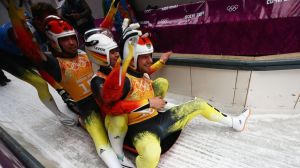
59. Luge Relay- From Total Pro Sports: “I know nothing about luge, so while it looks like something almost any decent athlete could do, I’m inclined to assume I just don’t know what I’m talking about, and that there’s actually a lot more to it. Besides, even if it is just extreme sledding, it’s still pretty fun to watch for a little while. You know where they lost me, though? With the luge “relay.” I tuned in thinking, okay, this should be pretty interesting. Is there a baton? How do they hand it off? Then I realized, oh, this isn’t really a relay. It’s just four separate races in four disciplines, then they add up the times. What’s exciting about that? Figure out how to work a baton into the equation, then we’ll talk.”

60. Nordic Combined- From Total Pro Sports: “The nordic combined, in case you didn’t realize, combines cross-country skiing and ski jumping. And that sounds kind of okay, since ski jumping is pretty badass, and cross-country skiing can be entertaining over shorter distances. However, like all multi-discipline Olympics events, you don’t really get to see people who are the best at any one thing. You get to see people are pretty good at a couple of things. Here’s the bigger problem with nordic combined, though. The cross-country portion isn’t a sprint, which is fun to watch. It’s 10km for the individual events and 4x5km for the relays. That means, in all likelihood, those races are going to be total snooze-fests.”
61. 10,000 Meter Speed Skating- From Total Pro Sports: “What most of us cannot watch, though, is the men’s 10,000 meter race. Fourteen people compete in the event going two at a time, and each person takes somewhere between twelve and thirteen minutes. That adds up to 91 minutes of watching people skate in circles, which is pretty much insufferable.”

62. Beach Volleyball – From Total Pro Sports: “Yeah, I know everyone loves beach volleyball on account of the minimalist uniforms. But when you actually stop and think about the sport itself, you realize it’s pretty dumb. Why? Because it’s played on sand, which is probably the dumbest sports playing surface ever devised. It’s like someone thought, “hey, is there anyway we could take a frenetic, action-packed sport like volleyball and slow it down? Oh, I’ve got it, let’s play it on sand.” Are the athletes who play beach volleyball impressive? Sure they are. But there’s still no denying that something people used to do on the beach to work up a sweat before swimming has become an Olympic sport. What’s next? Paddle ball? Frisbee? I feel fairly confident that, if the women didn’t wear tiny bikinis, this would not be an Olympic sport.”

63. Synchronized Diving- From Total Pro Sports: “Synchronized diving is regular diving that is watered down. How so? Because instead of simply judging how awesome or not awesome a particular dive is, they judge how synchronized it was. Thus, if your synchronized diving partner isn’t as good as you, you can’t do the best dive you’re capable of. So the overall quality of the competition is watered down. Of course, some would say, “oh, but the synchronization is what’s so great,” to which I would say, uh, no. They don’t have synchronized javelin throwing, or synchronized balance beam, do they? No, because everyone knows that would be dumb.” Makes solo synchronized swimming seem less stupid by comparison.

64. Steeplechase- From Total Pro Sports: “In case you don’t know what the steeplechase is, it’s that race at the Olympics where the runners have to leap over hurdles and puddles of water. It originated in England in the mid 1800s as a kind of cross-country race. Athletes would run from one town to the next, using the steeples of the town’s churches as guides, leaping over walls and streams along the way. When the modern Olympics were conceived, they included a track version of the event, and it’s been there ever since, even though it’s just plain stupid. (Jumping over puddles? Really?) And hey, I’m not the only one who thinks it’s stupid. The IAAF didn’t include the steeplechase in it’s World Championships until 2005. So they waited over a hundred years for this dumb event to die out before giving up.”
65. 100m Running Deer Shooting (1908-1948)- From Topend Sports: “There were two different variations of the event, single-shot and double-shot, based on the number of shots fired at the target during each run. The event consisted of a deer-shaped target which made ten 75-feet runs. Depending on the code of the event, shooters took one or two shots at the target during each run. Each run, which lasted for about 4 seconds, took place at a distance of 110 yards distant from the shooter. The target had three concentric circles. The smallest circle carried four points, three for the middle circle, and the outermost circle carried two points. A shot that hit the target outside of the circles also counted for one point as long as the hit was not on the haunch. The event was judged for a maximum of 80 possible points.” So I guess it’s supposed to be some sort of simulated deer hunting.
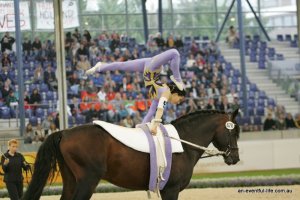
66. Equestrian Vaulting (1920)- From Topend Sports: “Men’s Vaulting was an equestrian event contested as a part of the Summer Olympics during the 1920 games. It was called figure riding or vaulting (or in French l’epreuve de voltige, meaning the acrobatic event). Essentially it is gymnastics and dance on horseback. It was the only time the event was conducted in the Olympics after which it was discontinued. The event consisted of four legs. In the first leg, riders had to jump onto the horse from a standing position and then jump back to the ground. Athletes had to repeat the same jump and back from both the left side and the right side. The second leg was to jump over the horses. Jump over one and more horses with a salto was third. Fourth leg was to ride with a walking horse.” Horse gymnastics, really?
67. Pole Archery (1920)- From Topend Sports: “The event consisted of shooting artificial birds that were placed on cross beams suspended from a large pole. Two types of pole archery events were conducted in the 1920 Olympics, an individual event and team event. For each of the two types there were two codes of competition, small birds and large birds, depending on the size of the birds that were used as targets.” It’s like clay pigeon shooting for archers.
68. Singlesticks Fencing (1904)- From Topend Sports: “Singlestick was a type of fencing event in which a wooden stick, known as the singlestick, was used as the weapon. The rules of the fight remained the same for the singlestick as it was for the other fencing events. The sport was contested as a part of the Olympics only once in 1904 and was discontinued after that due to lack of participation. Even in 1904 games, the only time the singlestick fencing event took place in the Olympics, only three competitors took part in the event. Among the three fencers, two of them were from the United States and one was from Cuba.” So I guess this sport wasn’t very popular for competition.

69. 12 Hour Bicycle Race (1896)- From Oddee: “They might have bitten off more than they could chew with this event. Seven riders got on their bikes at 5 a.m. and rode until 5 p.m. Four bikers dropped out before noon, but the winner, Adolf Schmal of Austria, managed about 180 miles. Only Schmal and one other competitor finished; Schmal won because he had lapped the other racers early on, so he was ahead by one lap.”

70. All-Around Dumbbells (1904)- From History Channel: “Purportedly designed to determine the world’s strongest man, the all-around dumbbells contest was held just once—over two days during the 1904 Games in St. Louis—and included a freestyle component. Participants performed nine lifts, including arm curls and shoulder presses. Unfortunately, crucial details about the dumbbell competition remain sketchy. Were the lifts performed multiple times with dumbbells of increasing weight, for example? It’s a key question, especially since a 1903 article in the New York Times reported that one of the events consisted of “tossing up one dumbbell from the ground to the shoulder.” This would have been an impressive sight if the strongmen were throwing 50-pound dumbbells around. The competitors also engaged in a freestyle demonstration of “original feats” of the athletes’ choice. Sadly, few photos of the event exist to help fill in the details about what these feats entailed. After this lone appearance, all-around dumbbells never again showed up on the Olympic sports roster.”


“the long jump, but with the possibility of drowning.”!!! 🙂
I can see why these sports didn’t catch on!